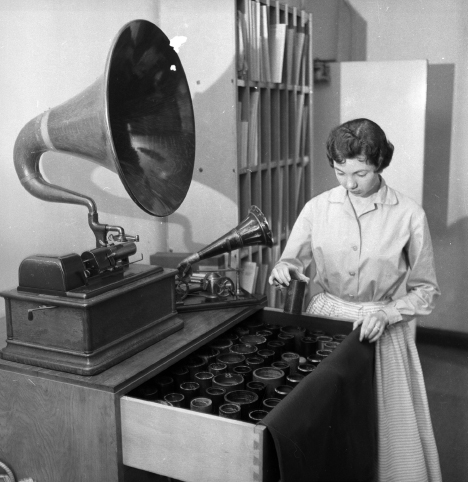From Cylinders to Disks: Sound Recording Becomes a Mass Medium
Printed Page 129
In the development stage of sound recording, inventors experimented with sound technology. In sound recording’s entrepreneurial stage, people sought to make money from the technology. Finally, sound recording reached the mass medium stage when entrepreneurs figured out how to quickly and cheaply produce and distribute many copies of sound recordings.
The Development Stage
In the 1850s, the French printer Edouard-Leon Scott de Martinville conducted the first experiments with sound recording. Using a hog’s-hair bristle as a needle, he tied one end to a thin membrane stretched over the narrow part of a funnel. When he spoke into the wide part of the funnel, the membrane vibrated, and the bristle’s free end made grooves on a revolving cylinder coated with a thick liquid. Although de Martinville never figured out how to play back the sound, his experiments ushered in the development stage of sound recording.
The Entrepreneurial Stage
In 1877, Thomas Edison helped move sound recording into its entrepreneurial stage by determining how to play back sound and market the machine to do it. He recorded his own voice by concocting a machine that played foil cylinders, known as the phonograph (derived from the Greek terms for “sound” and “writing”). Edison then patented his phonograph in 1878 as a kind of answering machine. In 1886, Chichester Bell and Charles Sumner Tainter patented an improvement on the phonograph, known as the graphophone, that played more durable wax cylinders.2 Both Edison’s phonograph and Bell and Tainter’s graphophone had only marginal success as a voice-recording office machine. Yet these inventions laid the foundation for others to develop more viable sound recording technologies.
The Mass Medium Stage
Adapting ideas from previous inventors, Emile Berliner, a German engineer who had immigrated to America, made sound recording into a mass medium. Berliner developed a turntable machine that played flat disks, or “records,” made of shellac. He called this device a gramophone and patented it in 1887. He also discovered how to mass-produce his records by making a master recording from which many copies could be easily duplicated. In addition, Berliner’s records could be stamped in the center with labels indicating song title, performer, and songwriter.

By the early 1900s, record-playing phonographs were widely available for home use. Early record players, known as Victrolas, were mechanical and had to be primed with a crank handle. Electric record players, first available in 1925, gradually replaced Victrolas as more homes were wired for electricity.
Recorded music initially had limited appeal, owing to the loud scratches and pops that interrupted the music, and they contained only three to four minutes of music. However, in the early 1940s, when shellac was needed for World War II munitions, the record industry began manufacturing records made of polyvinyl plastic. The vinyl recordings (called 78s because they turned at seventy-eight revolutions per minute, or rpms) were less noisy and more durable than shellac records. Enthusiastic about these new advantages, people began buying more records.
In 1948, CBS Records introduced the 331/3-rpm long-playing record (LP), which contained about twenty minutes of music on each side. This created a market for multisong albums and classical music, which is written primarily for ballet, opera, ensemble, or symphony and continues to have a significant fan base worldwide. The next year, RCA developed a competing 45-rpm record featuring a quarter-size hole in the middle that made it easy to play the records in jukeboxes. The two new recording configurations could not be played on each other’s machines, so a marketing battle erupted. In 1953, CBS and RCA compromised. The LP became the standard for long-playing albums, the 45 became the standard for singles, and record players were designed to accommodate both formats (as well as 78s, for a while).